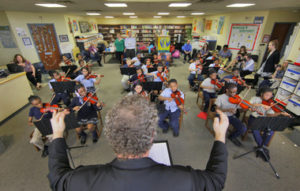
29 Jun Charter school critics keep coming up short: Opinion
 Jeff Grogan, Conductor of the Greater Newark Youth Orchestra conducts a class of 4th-6th graders at the University Heights Charter School who have been playing violin after school for only 4 weeks, during a rehearsal at the school. The pilot program with the NJSO culminates with a concert for family and friends. Recent studies show that elementary school pupils in charter schools often outperform their public school district counterparts.Tony Kurdzuk/The Star-Ledger
Jeff Grogan, Conductor of the Greater Newark Youth Orchestra conducts a class of 4th-6th graders at the University Heights Charter School who have been playing violin after school for only 4 weeks, during a rehearsal at the school. The pilot program with the NJSO culminates with a concert for family and friends. Recent studies show that elementary school pupils in charter schools often outperform their public school district counterparts.Tony Kurdzuk/The Star-Ledger
The recurring joke in “Peanuts” involves Lucy teeing up a football for Charlie Brown to kick. Just as he reaches the ball, Lucy pulls it away, laughing as poor Charlie Brown lands on his back. Each time, Charlie is skeptical, but ultimately is won over by Lucy’s insistence that this time, she really means it.
We were reminded of this cartoon when a new charter school study was released by Mathematica, showing that over a three-year period, KIPP charter students gained an average of 11 months’ learning in math and eight months in reading than district school peers.
Over time, many charter school critics have responded to new research findings following Lucy’s playbook. If the evidence were just a little stronger, they claim, they would agree charter schools are effective. Each time, they yank the football, finding some new flaw.
This tactic is repeated so often, we wonder whether critics will ever play by their own rules. Based on the history of charter school research, we have identified a pattern.
Early on, critics needed only say there was no evidence of charter school effectiveness. Charters were untested and unproven — a risky proposition. As evidence emerged, critics pulled away the football. “Yes,” they said, “but the findings are mixed and the methodology is weak.”
So researchers such as Phillip Gleason at Mathematica, Harvard’s Roland Fryer, Joshua Angrist at MIT and Justine Hastings of Brown University, among others, delved deeper, conducting more rigorous studies.
All available high-quality evidence on charter schools was examined in a 2011 meta-analysis conducted by Julian Betts at the University of California, San Diego. The pattern of findings became clearer: The study found charter schools tend to outperform local districts at the elementary and middle school levels and in urban areas. Those at the high school level and in the suburbs tend to struggle.
These positive findings for urban charters are reinforced by recent research by CREDO at Stanford University, which had produced a 16-state study in 2009, often cited by critics. The five newest reports, all released in the past six months, show that charter schools in Newark, Boston, Indianapolis, Harlem and Detroit are raising student achievement at a rate significantly greater than nearby districts.
Whenever new results like these are released, critics pull the football again. Some claim good results occur because charters take only the best students. Responding to CREDO’s positive Newark results, Bruce Baker of Rutgers University wrote: “Charter schools (in Newark) end up having far fewer of the lowest-income students.”
But researchers have studied charters’ enrollment. Caroline Hoxby in New York City and Mathematica’s analysis of KIPP have found evidence that charter school students in these areas are more disadvantaged and often enter with lower test scores than their district peers.
Critics also argue charter gains result from student attrition. Diane Ravitch wrote charter schools “are also free to push out low-scoring students and send them back.” But Ron Zimmer of Vanderbilt University and, separately, Mathematica find no evidence to support the attrition claim.
And now, the latest excuse: Charter schools get better results because they are better-funded. As Kevin Welner of the University of Colorado-Boulder wrote: “The true secret (of KIPP’s success) is more money, something public schools are starving to get.”
Except this criticism has shown to be lacking by research on charter school funding inequities by Ball State University. That 2010 data showed that, nationally, urban charter schools receive 72 cents on the dollar per student. A new University of Arkansas study released this month shows charter schools receive on average $4,000 less per student in five major regions, including Los Angeles and Washington, D.C.
When enough researchers have debunked the claim that charter successes are all about resources, these Lucys will pull the football away again, coming up with some other reason why the evidence on charter schools isn’t what it appears to be. It’s time to stop falling for these tricks.












No Comments